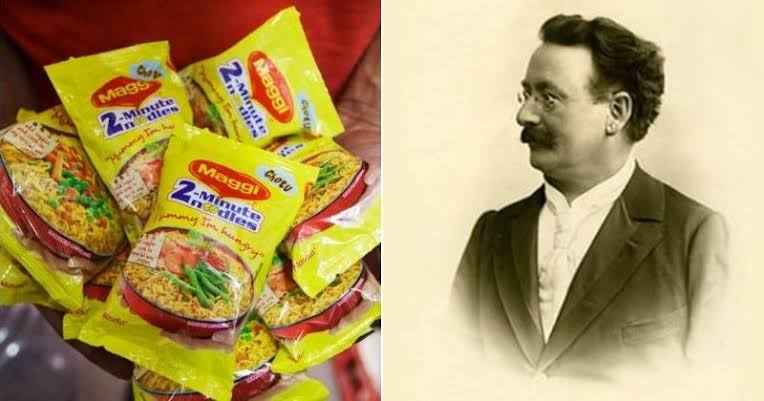In the vast culinary landscape of India, where spices and flavors reign supreme, one brand has managed to carve out a special place in the hearts and kitchens of millions: Maggi. This humble packet of instant noodles has become an integral part of the Indian food culture, and its journey from the Swiss mountains to Indian homes is nothing short of fascinating.
The story begins in the scenic town of Kemptthal, Switzerland, in the late 19th century. It was here that Julius Maggi, a young and enterprising entrepreneur, set out to revolutionize the way people cooked. Recognizing the growing need for quick and nutritious meals, Julius Maggi developed a formula for a concentrated, flavor-packed soup mix that could be prepared in minutes. This innovative product laid the foundation for what would later become the Maggi brand.
In the year 1884, Julius Maggi, a young and visionary entrepreneur, conceived an idea that would bring about a revolutionary change in the culinary world. His goal was to provide a practical solution for busy families who lacked the time to cook wholesome meals at home. Recognizing the increasing number of women entering the workforce and having less time for traditional cooking, Julius Maggi saw a genuine demand for affordable, delectable meals that could be prepared swiftly and effortlessly.
Julius Maggi, the visionary behind the Maggi brand, understood the significance of a strong brand identity in capturing consumer loyalty. He took extensive measures to safeguard and promote the Maggi brand. By 1900, Julius had meticulously registered his signature and various versions of his name in different typefaces across multiple countries. In Switzerland alone, he secured the protection of 18 distinct variations of his name, ranging from Magi to Magique, to deter potential imitators.
Right from its inception, Maggi products and promotional materials were instantly recognizable through their iconic color scheme of deep red, golden yellow, and black. Even today, many Maggi products available in African markets bear the cross-star symbol that Julius himself designed. This symbol serves as a visual representation of the brand’s heritage and enduring commitment to quality and taste. It acts as a unifying element, connecting consumers to the brand’s rich history and ensuring consistency across Maggi’s diverse product range.
Maggi Finds its Way to India
Fast forward to the 20th century when Maggi started its global expansion. In 1982, Nestlé, the renowned Swiss multinational, introduced Maggi noodles to the Indian market. It was a bold move to introduce a product that was entirely new to the Indian palate and cooking habits, which were deeply rooted in traditional recipes and slow-cooked meals. However, little did they know that this seemingly insignificant packet of noodles would soon become an intrinsic part of the Indian culinary fabric.
Maggi noodles faced an uphill battle in the early days. Indians were skeptical about this foreign import that promised a quick and tasty meal. To make matters worse, the initial marketing campaigns failed to resonate with the masses. However, Nestlé persisted and adopted a new strategy that would change the game forever.
The Bollywood Boost
Recognizing the power of popular culture, Nestlé launched a series of television advertisements that showcased Maggi noodles as the ultimate snack for busy individuals. These commercials featured Bollywood stars, who effortlessly prepared Maggi noodles and enjoyed them with a sense of youthful exuberance. This ingenious marketing campaign struck a chord with the Indian youth, who quickly embraced Maggi as their go-to comfort food.
As Maggi’s popularity skyrocketed, the brand expanded its range of offerings to cater to diverse tastes. They introduced various mouthwatering flavors, from masala to tomato and chicken, appealing to the vast and diverse Indian palate. Maggi even introduced an array of instant soups, sauces, and ketchups, further entrenching itself in Indian kitchen
The Maggi Controversy
Every journey has its ups and downs, and Maggi’s success story was no exception. In 2015, the brand faced its biggest challenge when the Food Safety and Standards Authority of India (FSSAI) reported that some Maggi noodle samples contained excessive levels of lead and MSG. This revelation sparked a nationwide controversy, leading to a temporary ban on Maggi noodles
Nestlé quickly went into damage control mode, working tirelessly to restore the trust of Indian consumers. They conducted rigorous quality tests, revamped their manufacturing processes, and collaborated closely with regulatory authorities. Maggi noodles made a triumphant comeback to the market within months, with stricter quality standards and a renewed commitment to food safety.
Today, Maggi is an integral part of Indian households, transcending generations and socioeconomic boundaries. It has become a symbol of comfort, convenience, and reliability. From hostel dorms to bustling households, Maggi noodles have made their way into the hearts of millions, becoming a cultural phenomenon in their own right.
The story of Maggi’s journey to India is a testament to the power of innovation, perseverance, and adaptability. What started as an experiment with instant soup mix in the Swiss mountains eventually transformed into an iconic brand that revolutionized the way Indians cook and consume food. Maggi’s enduring success in India is a true reflection of its ability to understand and adapt to the unique tastes and preferences of a diverse nation. So, the next time you savor a hot bowl of Maggi noodles, remember the remarkable journey it undertook to become an inseparable part of the Indian culinary landscape.



